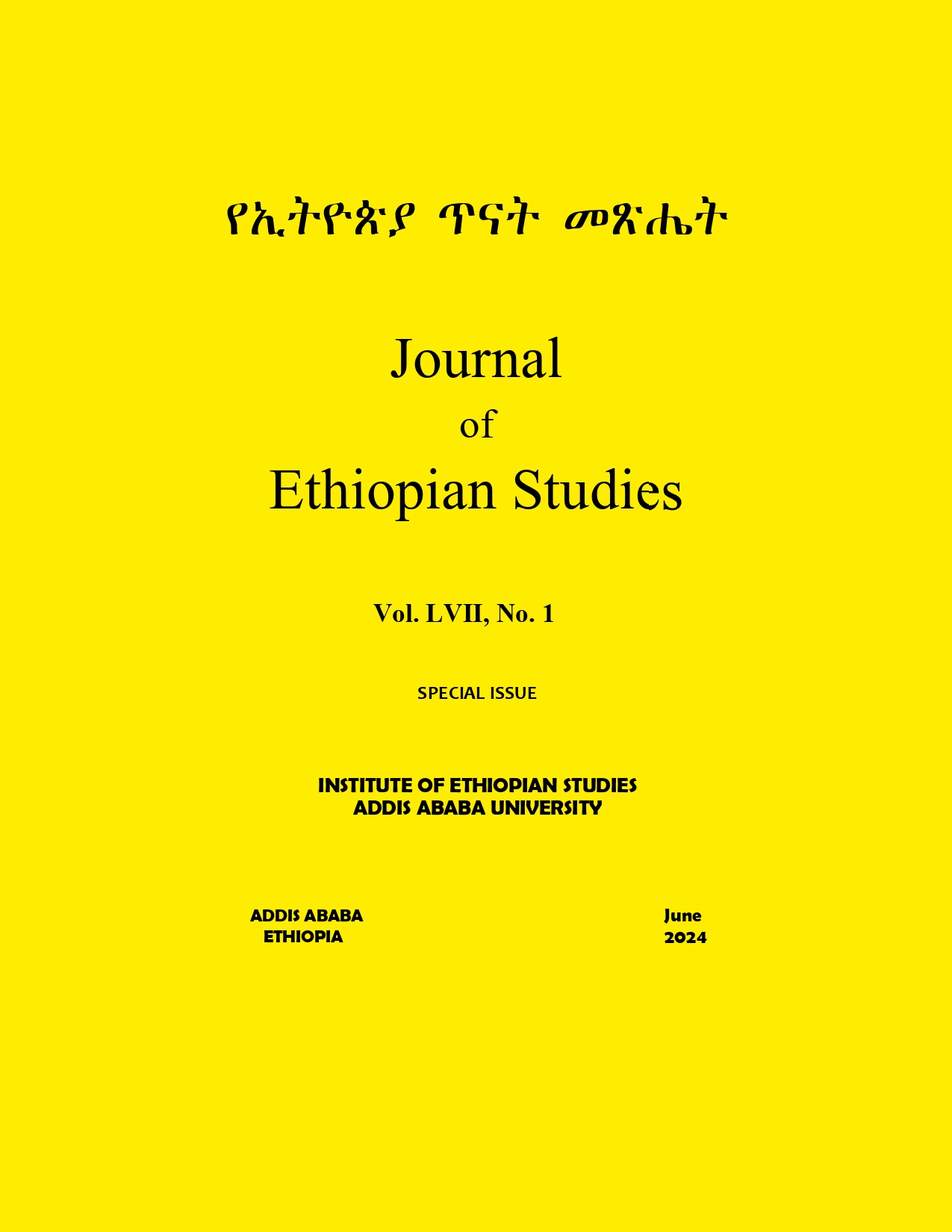በጥምቀት በዓል ላይ የተከሰቱ አበይት ሁነቶች እና የዘመን መንፈስ፤ በአዲስ አበባ፤ ጃን ሜዳ (ከ1917 ዓ.ም እስከ 1966 ዓ.ም)
Major Events in Epiphany Ritual and Zeitgeist, at Jan Meda in Addis Ababa (from 1925-1974)
Keywords:
Epiphany Rituals, Oral History, Zeitgeist, Oralized History, Jan Meda, የጥምቀት በዓል፣ ቃላዊ ታሪክ፣ የዘመን መንፈስ፣ ‹‹ኦራላይዝድ ሂስትሪ››Abstract
የዚህ ጥናት ዓላማ የጥምቀት በዓል ላይ የተከሰቱ አበይት ሁነቶች በማሳየት በወቅቱ የነበረውን የዘመን መንፈስ መመርመር ነው፡፡ ጥናቱ በአዲስ አበባ ከተማ በሚገኘው ጃን ሜዳ በሚባለው ስፍራ ከ1917 ዓ.ም እስከ 1966 ዓ.ም ድረስ ባሉት አመታት የተከበሩ የጥምቀት በዓላት ላይ የተከሰቱ አበይት ሁነቶችን በቅደም ተከተል በማቅረብ ላይ ያተኮረ ነው፡፡ ጥናቱ አይነታዊ የምርምር ስልትን የተከተለ ሲሆን፣ በቃላዊ ታሪክ የፎክሎር ጥናት ዘርፍ የሚመደብ ነው፡፡ ለጥናቱ ጠቃሚ የሆኑ ቀዳማይና ካልዓይ መረጃዎች ተሰብስበዋል፡፡ ለቀዳማይ መረጃዎች ቃለመጠይቅና ንጥል ሁነት ማሳያ የመረጃ መሰብሰቢያ ዘዴዎች ተግባራዊ የተደረጉ ሲሆን፣ ከተለያዩ መዛግብት የተገኙ ካልዓይ መረጃዎችም ጥቅም ላይ ውለዋል፡፡ በእነዚህ ዘዴዎች የተሰበሰቡ መረጃዎች ያላቸውን ትርጉምና በወቅቱ የነበረውን የዘመን መንፈስ ለመመርመር ‹‹ኦራላይዝድ ሂስትሪ›› የንድፈሃሳብ መንገድን የተከተለ ነው፡፡ በእነዚህ ዓመታት በተከበሩ የጥምቀት በዓላት ወቅት ንጉሱ፣ መኳንት፣ መሳፍንት፣ የኃይማት አባቶች በስፍራው በመገኘት የተለያዩ መንፈሳዊና ዓለማዊ ስርዓቶችን ይፈጽሙ እንደነበር ጥናቱ ያሳያል፡፡ የጥምቀት በዓልም ከኃይማኖታዊ ስርዓትነቱ በተጨማሪ የተለያዩ ማህበራዊና ፖለቲካዊ ጉዳዮች ማከናወኛ ሕዝባዊ መድረክ በመሆንም ያገለግል እንደነበር ጥናቱ ያሳያል፡፡ በጃን ሜዳ በተከበሩ የጥምቀት በዓላት ላይ ከተለያዩ አለማት የመጡ የኃይማኖት አባቶች፣ ዲፕሎማቶች፣ አምባሳደሮችና የሀገራት መሪዎች ይገኙ ነበር፡፡ ይህም የጥምቀት በዓል ለዲፕሎማሲ፣ ለሕዝብ ለሕዝብ ትስስርና ለሀገር ገጽታ ግንባታ ከፍተኛ ሚና እንደነበረው ጥናቱ ያሳያል፡፡ ሀገሪቱ ውስጥ የተከሰቱ አበይት ታሪካዊ ሁነቶች በጥምቀት በዓል አከባበር ላይ የፈጠሩት ተጽዕኖ እንዲሁም የዘመኑን መንፈስ እንደሚያሳዩ ጥናቱ አመላክቷል፡፡
This study aims to analyze the zeitgeist in the epiphany ritual, focusing on major events that happened from 1925 to 1974. Specifically, the study examines the Epiphany ritual held at Jan Meda in Addis Ababa and the major events during those years, presenting these events chronologically. The research adopts a qualitative methodology from a folklore studies perspective, utilizing an oral history approach. In the study, primary and secondary data were collected and used. Primary data were collected using interviews and case study data-gathering techniques, while secondary data were gathered from archival sources. The data were analyzed qualitatively. In analyzing and interpreting the zeitgeist within the temporal time, “Oralized History” was used as a conceptual framework. The findings reveal that, during the specified period, the Epiphany rituals were significant as religious events and sociopolitical and cultural platforms. In the Epiphany rituals, major events, which are religious and secular, happened with the attendance of Emperor Haile Selassie, members of the nobility, judicial authorities, and spiritual leaders. The Epiphany ritual was used as a major venue for diplomatic engagement, fostering people-to-people connections and contributing to nation-building. This is also evidenced by the attendance of spiritual leaders, diplomats, ambassadors, and heads of state from diverse nations at the Jan Meda rituals. Finally, the study underscores the reciprocal relationship between historical events and the ritual of the Epiphany, demonstrating how the sociopolitical dynamics of the time influenced the ritual's practices and how, in turn, these practices reflected and shaped the spirit of the time.


